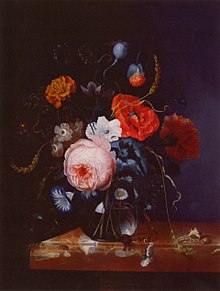Johann Adalbert Angermayer
A request that this article title be changed to Johann Adalbert Angermayer is under discussion. Please do not move this article until the discussion is closed. |

41×32cm
Johann Adalbert Angermeyer, Jan Vojtěch Angermayer in Czech, (1674–1742), was a painter, born in Bílina, Habsburg Monarchy. He specialized in cabinet still life compositions. Since 1699, he studied in Prague under Johann Rudolf Byss and is recorded there as a member the Old Town Painter Guild between 1707 and 1727. He was known to paint counterparts to older solitary still life paintings, as was fashionable at the time. Some of his students include John Caspar Hiršely and Carl Kastner.[1]
Biography

20×16cm
He was born on 9th November 1674 in Bílina. Since 1699, he lived in Prague, where he studied under Johann Rudolf Byss, who came to Prague seven years earlier. Johann Adalbert joined the Old Town Painter Guild in 1707. He built a reputation for his patiently detailed paintings of still life, often quite small in size. Among his pupils belong the early Roccoco painter John Caspar Hiršely and Carl Kastner. Other than his work stay at the Monastery of Osek (1719–1722), Johann Adalbert Angermayer spent most of his life in Prague, where he died on 10th Mai 1742.
Topics and style
Angermayer painted flowers, fabrics, hunting trophies and quiet scenes from nature as was customary, but also nontraditional compositions like his Still Life with a Watch or Still Life with a Jewelery Box (1708). He was greatly influenced by the Leiden Fijnschilders,[2] as was his teacher Johann Rudolf Byss, who studied in Netherlands. Angermayer was known for his skill of realistic portrayal of details. Most of his work can be classified as cabinet still life, because the width or height of his paintings rarely exceeds 35 cm.
References
- ^ Siefertová, Hana (1979). Georg Flegel a kabinetní zátiší v Čechách v 17. a 18. století (exhibition catalogue) (in Czech). Prague - available in Czech National Library: Czech National Gallery. p. 39.
- ^ Vondráčková, Marcela, ed. (2013). Baroko v Čechách: průvodce stálou expozicí Národní galerie v Praze, Uměleckoprůmyslového musea v Praze a Archeologického ústavu Akademie věd ČR, Praha (in Czech). Prague: Národní galerie. pp. 123–124. ISBN 978-80-7035-527-5.
